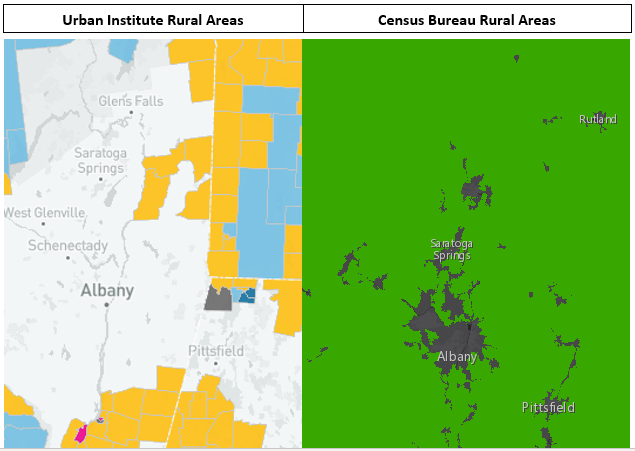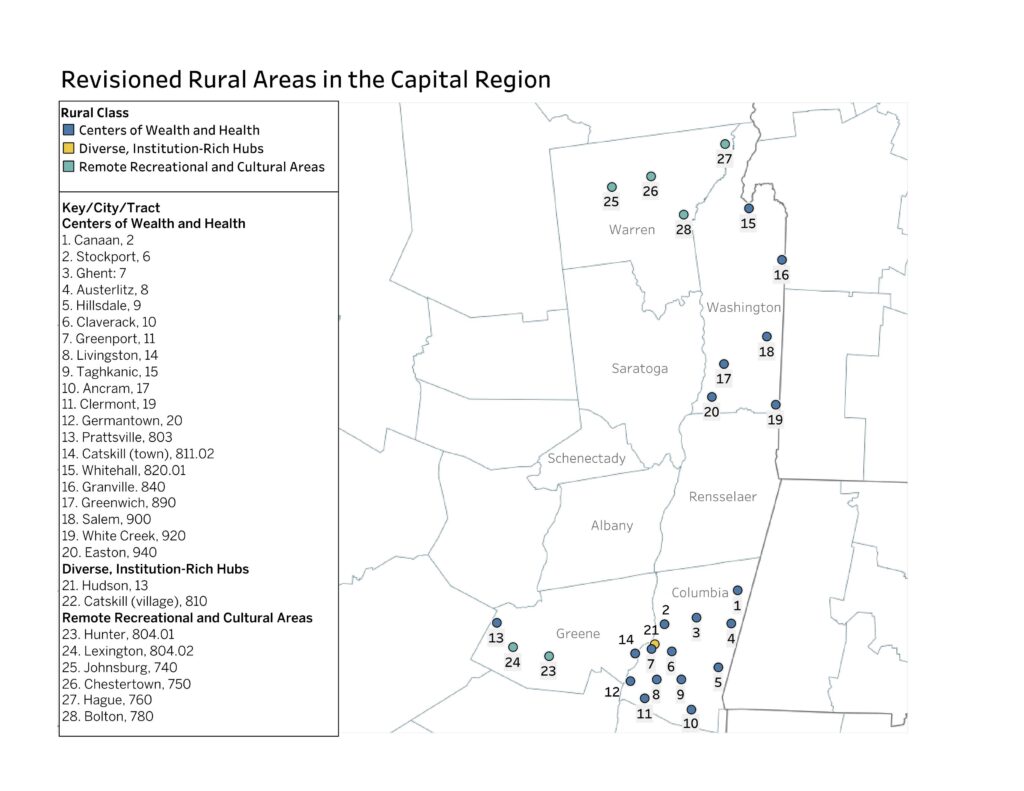A Reenvisioning of the Capital Region’s Rural Areas
An Urban Institute “Reenvisioning of Rural America” is honing in on the strengths and potential of the Capital Region’s rural communities while also concentrating the size of its rural footprint.
Whereas the federal government has traditionally negatively defined rural areas as any non-urban areas, a new Urban Institute study instead defines rural census tracts based on their resources, diversity, and potential. Focusing on these strengths, the Urban Institute analyzed 13,000 census tracts in micropolitan, small town and isolated rural areas and categorized them under seven groups.
Urban and Rural Areas
Only 28 Capital Region census tracts in four counties – Columbia, Greene, Warren, Washington – fell within three of the re-envisioned rural groups. Those tracts have a population of 82,104 and spanned a land area of 1,588 square miles. That is a substantially smaller land area footprint than the 4,754 total square miles in the region designated as rural areas by the U.S. Census Bureau.

The Capital Region houses three urbanized areas: Albany-Schenectady, Glens Falls and Saratoga Springs. It also has 10 urban clusters: Catskill, Corinth, Coxsackie, Granville, Greenwich, Hoosick Falls, Ravena, Valatie and Warrensburgh. The region’s total Census Bureau designated urban land area footprint is 416 square miles.
Reenvisioned Rural Groups
The three re-envisioned rural groups in the Capital Region were “Diverse, Institution-Rich Hubs,” “Centers of Wealth and Health” and “Remote Recreational and Cultural Areas.” Twenty of the region’s 28 reenvisioned rural tracts were classified under the Centers of Wealth and Health, which are tracts that are strongest across the largest number of quality of life, economic, financial, social and other metrics. Twelve of these Centers of Wealth and Health are in Columbia County, two in Greene and six in Washington. The Urban Institute notes, “This group does not have any notable challenges, with scores around the average across every other measure.”

The region’s two Diverse, Institution-Rich Hubs were tracts in Catskill and Hudson. These hubs are racially and ethnically diverse and “have strong access to community institutions and health facilities, as well as the greatest amount of community development investment.” Challenges faced by these hubs are “limited financial resources, low labor force participation rates, the lowest life expectancy, the worst air quality, and the lowest share of households with access to home broadband or a cellular data subscription.”
The region also had seven Remote Recreational and Cultural Areas, with three in Greene County and four in Warren County. Parks, such as the Catskills or Adirondacks, on average cover more than three quarters of these tracts, which have the “highest capacity of cultural organizations and the highest financial capacity per 1,000 people of social welfare organizations. This group also has the highest density of historic properties and the best access to child care centers.” However, “This group lacks access to many services; it has the lowest proximity to fire stations and emergency medical services, banks and credit unions, health care facilities, public libraries, and schools. This group also has the second-lowest access to transportation stations and terminals, the lowest census participation rate, and the fewest hospital and nursing home beds per capita.”
CEG Initiatives
The Center for Economic Growth has been supporting economic growth in the Capital Region’s reenvisioned rural areas through the work of its Business Growth Solutions, which helps urban and rural manufacturer, such as White Creek in White Creek, become more efficient and skill up their labor force. CEG is also working to attract talent to the region by highlighting its rural communities, such as Catskill, Hudson and Washington County through its CapNY talent attraction tool. CEG also supported the Capital Region Economic Development Council (CREDC) in preparing its 2021 Strategic Update, which features a new Magnet strategy that targets urban and rural communities in need of economic diversification. Eleven of the Urban Institute’s reenvisioned rural census tracts were also designated by the CREDC as “Magnet communities.”
Don’t miss these insights into the trends that are shaping the Capital Region’s economy. Sign up for CEG’s e-news and follow us on:













